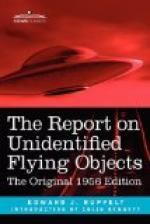The summary of the press conference straightened things out to some extent and our flow of reports got back to normal.
I was anxious to start enlisting the aid of scientists, as General Samford had directed, but before this could be done we had a backlog of UFO reports that had to be evaluated. During July we had been swamped and had picked off only the best ones. Some of the reports we were working on during August had simple answers, but many were unknowns. There was one report that was of special interest because it was an excellent example of how a UFO report can at first appear to be absolutely unsoluble then suddenly fall apart under thorough investigation. It also points up the fact that our investigation and analysis were thorough and that when we finally stamped a report “Unknown” it was unknown. We weren’t infallible but we didn’t often let a clue slip by.
At exactly ten forty-five on the morning of August 1, 1952, an ADC radar near Bellefontaine, Ohio, picked up a high-speed unidentified target moving southwest, just north of Dayton. Two F-86’s from the 97th Fighter-Interceptor Squadron at Wright-Patterson were scrambled and in a few minutes they were climbing out toward where the radar showed the UFO to be. The radar didn’t have any height-finding equipment so all that the ground controller at the radar site could do was to get the two F-86’s over or under the target, and then they would have to find it visually.
When the two airplanes reached 30,000 feet, the ground controller called them and told them that they were almost on the target, which was still continuing its southwesterly course at about 525 miles an hour. In a few seconds the ground controller called back and told the lead pilot that the targets of his airplane and the UFO had blended on the radar-scope and that the pilot would have to make a visual search; this was as close in as radar could get him. Then the radar broke down and went off the air.
But at almost that exact second the lead pilot looked up and there in the clear blue sky several thousand feet above him was a silver-colored sphere. The lead pilot pointed it out to his wing man and both of them started to climb. They went to their maximum altitude but they couldn’t reach the UFO. After ten minutes of unsuccessful attempts to identify the huge silver sphere or disk—because at times it looked like a disk—one of the pilots hauled the nose of his F-86 up in a stall and exposed several feet of gun camera film. Just as he did this the warning light on his radar gun sight blinked on, indicating that something solid was in front of him—he wasn’t photographing a sundog, hallucination, or refracted light.
The two pilots broke off the intercept and started back to Wright-Patterson when they suddenly realized that they were still northwest of the base, in almost the same location they had been when they started the intercept ten minutes before. The UFO had evidently slowed down from the speed that the radar had measured, 525 miles an hour, until it was hovering almost completely motionless.




